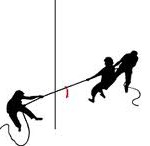 The term “bellwether” comes from the Middle English bellewether. It refers to the practice of placing a bell around the neck of a castrated ram (a wether) leading a flock of sheep. The movements of the flock can then be predicted (or followed) by hearing the bell without actually seeing the flock.
The term “bellwether” comes from the Middle English bellewether. It refers to the practice of placing a bell around the neck of a castrated ram (a wether) leading a flock of sheep. The movements of the flock can then be predicted (or followed) by hearing the bell without actually seeing the flock.
Animal shelters are a sort of bellwether when it comes to predicting or following pet disease trends in our communities. Sadly, our local bellether suggests we may see an upswing in the number of cases of parvovirus in puppies and young dogs in my community – unless we proactively use this information to protect our pets.
While the situation is contained at the local shelter, this important “bellwether” information should be used by pet owners because this disease poses a life-threatening risk to your unprotected dogs, especially puppies.
The parvovirus is highly contagious and is transmitted through dog-to-dog contact, contaminated feces, environments and people.
Any surface a dog touches can harbor the virus, including his crate, food and water bowls, collar and leash, dog toys, etc. Other animals, people and even clothing can be contaminated.
Parvo is a resilient virus able to survive temperature and humidity extremes. A minute amount of contaminated feces can infect a large area, and consequently any dogs who pass through the area.
Canine parvovirus attacks the gastrointestinal tract of infected dogs. In puppies and those still in utero, the virus is known to damage the heart muscle. Symptoms are similar in all dogs and include loss of appetite; vomiting and severe, often bloody diarrhea; fever; lethargy; weakness and dehydration.
Dehydration can come on rapidly due to the vomiting and diarrhea, and is especially dangerous in puppies.
Most deaths from parvovirus occur within 48 to 72 hours after symptoms first appear, so it is critical you take your dog to your veterinarian immediately if you suspect a Parvo infection. Diagnosis requires blood and fecal tests.
It is a good idea to hospitalize your dog until her condition has stabilized. Your dog’s chances of survival are improved the sooner aggressive treatment begins – but do not expect your veterinarian to be able to predict an outcome immediately.
Unfortunately, treatment of Parvo can be expensive, with no guarantee your beloved pet will survive despite heroic efforts to save her. In some heartbreaking cases, pet owners simply cannot afford to even try to save their dogs, and euthanasia becomes the only option.
That is why an ounce of prevention is worth a pound of cure. Please make sure your puppy receives his core vaccines and your adult dog is current on all his vaccinations.
The vaccine protocol is to give one Parvo vaccine at around 9 weeks (but before 11 weeks), and a booster at around 14 weeks. For 14 days after your pup has received his second Parvo vaccine you should avoid allowing your dog any contact with unfamiliar dogs. Places you should exercise extreme caution include dog parks; doggie daycare or boarding kennels; and grooming shops.
Also, reduce or eliminate your dog’s exposure, no matter her age, to the feces of other dogs and all animals. Clean up your own pet’s waste as well.
Keep your dog away from sick pets, and if it is your dog that is sick, do not let him expose others. If you come in contact with a sick dog, wash your hands and change clothes if necessary before you handle another dog.
As we keep a vigilant eye on our local bellwether we can more strategically protect all our community’s pets.


 Six years ago this month I joined the Yavapai Humane Society (YHS) team as executive director. When I joined the YHS team I found an organization operating with some challenges — from a notable deficit, high employee turnover, and low morale.
Six years ago this month I joined the Yavapai Humane Society (YHS) team as executive director. When I joined the YHS team I found an organization operating with some challenges — from a notable deficit, high employee turnover, and low morale. The month of July is chock-full of patriotic festivities that include outdoor celebrations, picnics, barbecues, and of course, fireworks. Before you pack up for the lake or outdoor arena, stadium or even your own front yard to enjoy the pyrotechnic delights of the holiday, be aware of your pets’ needs and fears.
The month of July is chock-full of patriotic festivities that include outdoor celebrations, picnics, barbecues, and of course, fireworks. Before you pack up for the lake or outdoor arena, stadium or even your own front yard to enjoy the pyrotechnic delights of the holiday, be aware of your pets’ needs and fears. These are challenging times for government officials. In many communities the care of lost and homeless animals can be complicated by a host of competing priorities. When evaluating conflicting priorities it’s easy to look to the bottom line. When that happens, questions of compassion can be overlooked.
These are challenging times for government officials. In many communities the care of lost and homeless animals can be complicated by a host of competing priorities. When evaluating conflicting priorities it’s easy to look to the bottom line. When that happens, questions of compassion can be overlooked. The term “bellwether” comes from the Middle English bellewether. It refers to the practice of placing a bell around the neck of a castrated ram (a wether) leading a flock of sheep. The movements of the flock can then be predicted (or followed) by hearing the bell without actually seeing the flock.
The term “bellwether” comes from the Middle English bellewether. It refers to the practice of placing a bell around the neck of a castrated ram (a wether) leading a flock of sheep. The movements of the flock can then be predicted (or followed) by hearing the bell without actually seeing the flock. Part of my holistic approach to healthy, humane animal shelter management includes implementation of innovative
Part of my holistic approach to healthy, humane animal shelter management includes implementation of innovative